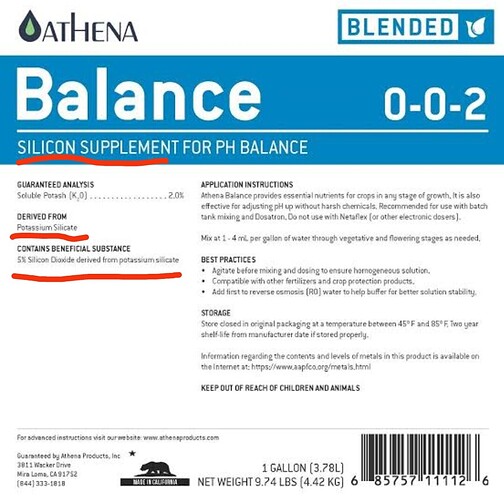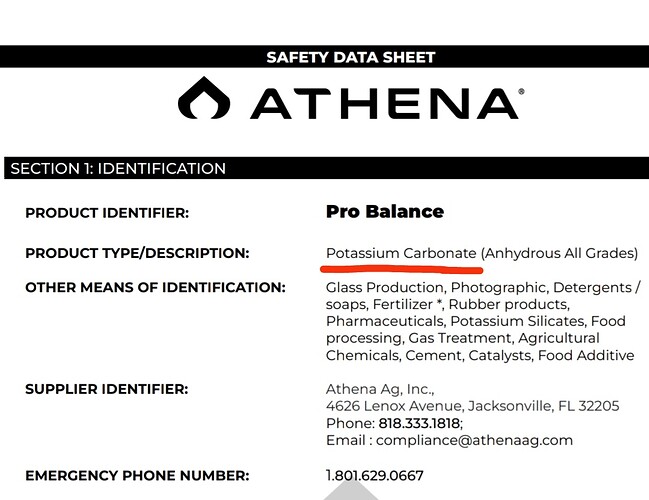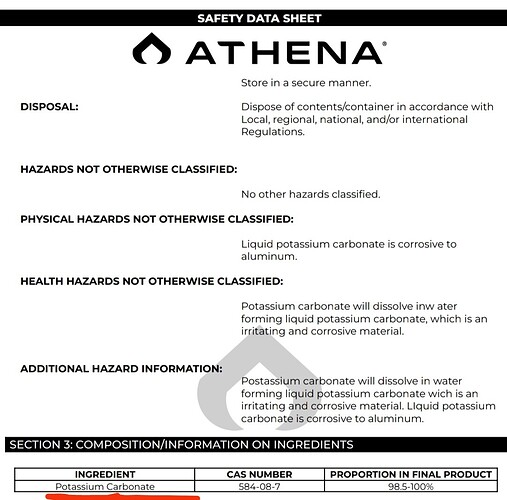@emdub27 I’ve been just using gh ph up professional, and I was wondering if you think there was a better option. Really I would like to try and find something that I can buy the raws and mix myself, I can’t find much info in my searches.
FWIW, I keep things simple. KOH FTW.
Great topic! Does anybody use hydrated lime for pH up?
Not for fertigation, or at least I hope not.
I personally use 1N KOH as a base.
In practice I rarely add a base to fertigation solution because I run enough Agsil that I need an acid.
I’ve been trying to find an anternative to KOH or KSil. Hard to source KOH and the potassium silicate has been reaction and creating insolubles in the lines. I haven’t gotten clogged drippers but I imagine the flow on some has decreased.
I had copied Josh’s formula (Morr/Jr Croptech) at:
153-150-359-216-83-178 not counting the KSil needed to raise the pH up back to 5.6-5.8
But I’ve currently moved mid cycle to:
136-66-294-205-65-168 not needing to add KSil to bring the pH up as it mixes to 5.8 spot on. I’ve been experimenting adding metalosate Ca and a liquid lithothamnium (calcareous algae) product to improve calcium uptake.
The hydrated lime idea came from looking online for agricultural solutions to increase the pH of the feed water.
That’s also what I use, @emdub27 : 1 N (1 M for KOH).
Note that for KOH (or NaOH) 1 N = 1 M because they have one equivalent, but that’s not the case for a solution with a solute with more than one equivalent like C2SO4 or K2SO4.
For those not used to molarity, 1 N (and 1 M) KOH works out to about 5.61% w/v of the KOH flakes.
To make a ~1L volume of 1 M KOH solution, add 600 grams of chilled distilled H2O (or RO water) to a calibrated graduated beaker, then slowly add 56.1 grams KOH mixing until dissovled. Top up the solution to 1,000 mL and mix.
When accounting for its ~90% purity, 1 M KOH flakes is ~5% pure KOH (w/v). That’s about 3.52% K (w/v) when accounting for the molar mass of K within KOH. Equating ~35,200 ppm K. 1 mL of 1 M KOH equals about 1.05 grams. You can use those values to calculate the added K from the KOH to your nutrient profile if you wish.
- When mixing KOH, make sure to respect its danger and use PPE (wrap around goggles, N/K 95 face mask, nitrile gloves, long sleeve shirt, pants, shoes) and mix slowly. It’s an exothermic reaction, so the solution will heat up quite a bit (especially if you add the KOH quickly). Add water first, then KOH, then an overhead mixing blade (or stirrer bar for small scale), and mix at medium RPM. The mixing and storage vessel should be HDPE or glass.
A little goes a long way.
Where do you live? What country?
Different continent, far away ![]() Now I remember one more reason I didn’t insist into looking further for KOH. It’s regulated and although I formulate my own nutrients, run automatic drip irrigation and monitor pwEC with a Teros 12, I am just an enthusiast growing for medical purposes.
Now I remember one more reason I didn’t insist into looking further for KOH. It’s regulated and although I formulate my own nutrients, run automatic drip irrigation and monitor pwEC with a Teros 12, I am just an enthusiast growing for medical purposes.
Once I saw all the precautions needed to mix it I decided not to add one more thing to worry about and went the silicate route. Now I’m looking for alternatives. I could also get calcium silicate but I imagine it would react even more, so my other options I gave some thought were CaCo3 (I think food grade is micronized), one of the CaCo3 amino chelates in suspension or also seems that dropping a good amount of MKP also worked.
Actually, since the post is about Athena, what’s up with their pH up/silicon product “Balance”? They advertise it as “not clogging drippers such as potassium silicate”, then you find the label online and it says “potassium silicate” on it. At the same time in a podcast with one of their scientists responsible for the formulations he is asked what’s in the product and he says “potassium carbonate”. Real weird information all over the place.
Do you have any precipitation with the agsil? I would really like to add some silica but I’m worried about having issues with my pressure compensated drippers.
Unfortunately I can’t get the balance in canada.
you realize this I’m sure but those are two different products. The pro balance is potassium carbonate and the blended balance is potassium silicate. Hth
Thought this was interesting…
Carbonates and bicarbonates will work for pH up and provide buffering capacity (by increasing alkalinity). Potassium carbonate or potassium bicarbonate would probably be a better choice than calcium carbonate. FWIW, General Hydroponics pH up is solution of potassium carbonate and potassium silciate, and EarthJuice pH up is just potassium bicarbonate powder.
GH pH UP SDS:
Bicarbonate is a weaker base, so you may have an easier time finding it in your country. And spaying leaves with potassium bicarbonate ( ideally with a surfactant) is an outstanding preventative and treatment for powdery mildew. It increases the leaf surface pH, which inhibits and knocks back PM. Check out Millstop SP from Bioworks; it’s a mixture of potassium bicarbonate and surfactant.
No precipitation at 10ish ppm Si. But I do not add KOH or anything else to the silicate stock tank and there is sedimentation in that stock tank. My injector pickups aren’t on the bottom of the tanks either. So that method may be helping.
I do run Si higher at times to combat disease pressure and definitely see sedimentation in the 30ppm Si range. When I do that, the entire fertigation system gets flushed with ro for the last several watering of the day.
Since you mentioned surfactants, I noticed you guys discussed it previously in the post. Any concerns regarding any of those?
Ethylene-glycol-monobutyl
a-Limonene 1-methyl-4-isopropenyl-1-cyclohexene
Citronelol 3,7-dimethyl-6-octen-1-ol
Thats in what I use to apply foliars and sometimes include in the irrigation ![]()
Need me to mail you some?
Today I learned there is an a-limonene. Does it have a citrus aroma?
Has anyone ever had the Core + Grow analyzed? Going off the label values, the difference between Core + Bloom and Core + Grow seems so small that I wonder if it is even worth keeping stock tanks for the Grow.
The only differences I see using Hydrobuddy and the bag labels-
| Core+Grow | 3+5g |
|---|---|
| N (NO3-) | 137 |
| K | 219 |
| P | 46 |
| Core+Bloom | 3+5g |
|---|---|
| N (NO3-) | 111 |
| K | 266 |
| P | 69 |
The sulfur is 106 vs. 119 ppm. The rest of the ingredients seem the same.
And I know the potassium might not even be that large of a difference because my Bloom test showed it to actually be 234 ppm. And the Nitrogen in Core + Bloom tested at 120 ppm N. So what are you really buying that is different in the Grow haha? 17 ppm N, 23 ppm P, and 15 ppm K? I guess I need to test the Grow to make sure.
At some point Ivan said the Jungleboys use the same thing on every plant in their facility (Marijuana Mania Episode 4: Los Angeles - YouTube). Maybe this was when they used Veg+Bloom (https://hydroponic-research.com/) nutrients? Of course that has changed now that they make their own nutrients. ![]()
Modern cannabis growing theory seems to have you vegging for such a short time I wonder if it even matters. I’m reminded of this golden oldie that showed you could get more growth with higher N in veg but the final yield remained the same.
“It was discovered that using 250ppm N during the growth stage produced no faster growth nor higher yields than using the 100ppm N found in his flowering profile (the one highlighted red in the For Flowering section below), and that the same flowering profile could also be used during the first two weeks of growth. It became apparent that using growth stage as a prerequisite for managing a cannabis crop’s nutrient profile was not only overstated, but strengths and profiles were overstated as well.”
Has anyone had just the Athena Core analyzed? Is it literally Calnit and Micros? If so it seems like you could run Athena for damn near the price of Jacks if you didnt have to buy Core and just got some Yara Calnit and Peters STEM. Athena is more accessible in my area.




